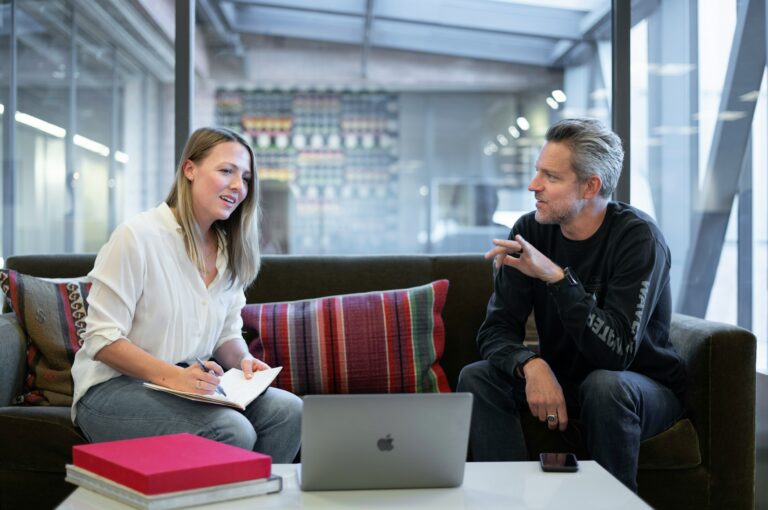The quality of your work environment has a significant impact on how well you do your job.
When you’re working in an encouraging setting amidst healthy relationships and atmosphere, you’re more likely to get things done, whereas when you’re not, you could find it quite difficult to focus and eventually excel at your job.
If you want to integrate well into the company and advance your career, it’s important to first get a feel for the work environment, if possible.
So, make sure you read this article to explore the different types of work environments, what elements constitute a stimulating and healthy one and much more!
Key Takeaways
- The term “work environment” refers to the totality of factors, both physical and cultural, that make up an organization.
- Seven types of work environments are conventional, competitive, artistic, flexible, collaborative, authoritarian, and the one accepting constructive feedback.
- You can find out about a company’s work environment by doing research, reading reviews, networking with current or former employees, asking questions, and examining available documents.
- As a leader, you may improve morale in the office by, among other things, sharing praise when it’s due, critiquing performance constructively, being honest with employees, and giving sufficient space to everyone.
What is a Work Environment?
An employee’s “work environment” refers to their physical surroundings and social dynamics when they are on the job.
It incorporates not just the physical features of a location but also its rules and other comparable characteristics.
You’ll be expected to conform to and adjust to any work environment you find yourself in, which can have a significant effect on your productivity.
If the color of the walls in your workplace is bothering you, for instance, all you can do is avoid looking at them. Or even if leading meetings is not your forte, you still need to learn how to do it effectively.
Physical Work Environment
Now that you are familiar with the meaning of the work environment, we can break down the physical elements of a typical workplace.
Size
The size of your office is determined by the square footage it has. The primary concern with the size is whether or not there will be adequate personal space for all of the company’s workers.
The more open and spacious a workplace is, the more independent its workers will feel. Some people may experience increased anxiety or even claustrophobia in a confined space, which can have a negative impact on their work performance and well-being.
Equipment
It is essential to check whether or not employees have access to the necessary tools during their employment.
Having the proper tools will, unsurprisingly, make or break a project. If the machinery is brand new and reliable, you’ll have an easier time getting everything done on schedule.
Here, it’s important to think about where the equipment will be kept and if it will be at the office or in storage. The convenience of its availability also has a significant bearing on productivity in the workplace.
Furnishing & Decoration
There is a strong correlation between the quality of a workplace and the furniture it provides.
Without proper furnishings, workers are less likely to stick around, and the company is more likely to experience high turnover.
This is why it is essential to have good furniture in every office, which includes ergonomic chairs and desks.
Safety
Keeping yourself safe is always important, but it’s especially important in the workplace, where you spend a significant portion of your day.
Knowing that your safety is ensured at work is crucial to your ability to relax and concentrate on your duties.
As such, it’s important to keep an eye out for things like fire alarms, a handy map, and clearly marked exits in the event of an emergency.
Company Culture as Work Environment
The company’s culture also plays a role in shaping the work environment.
It consists of features such as the following:
Leadership Style
The term “leadership style” is used to describe the approach taken by upper-level management to inspire employees to achieve optimal results in their roles.
Leadership style plays a crucial role since it determines the effectiveness of various approaches and techniques, which in turn affect the workers.
Autocratic, pacesetting, democratic, coaching, affiliate, and Laissez-faire leadership are just a few of the many possible styles. It’s important for job seekers to learn about the many types of leadership styles and identify the one with which they’re most comfortable.
Company Values & Mission
The company’s values and mission shape the culture of the business and, by extension, the atmosphere at work.
Working for a company whose values and goals are diametrically opposed to one’s own would naturally be challenging. There may be a lot of miscommunication and difficulty working together due to the distinction.
Hence, it is crucial that the values are consistent. If the worker can adopt the company’s tenets without rejecting their own, that’s even better.
Company Policies
Items such as the dress code, the attendance policy, the terms and conditions of employment, and so on are all part of a company’s set of rules, often known as its policies.
Employers implement all of these measures to ensure their staff adheres to the company’s standards and principles.
Simply put, this is the only way to guarantee that all workers are safe, receive fair treatment, and understand their responsibilities, among other things.
Employee Programs
Providing programs for employees is a terrific way to foster positivity in the workplace.
The term “employee programs” can refer to a wide range of initiatives designed to improve the lives of workers.
These kinds of incentives are a great way to show your staff that you value their professional and personal growth.
In addition to improving people’s health and productivity, these kinds of initiatives will encourage them to adopt a positive attitude toward their jobs.
7 Types of Work Environment
It’s very important to learn about these seven different work environment types before settling on a job because being able to differentiate between the right and wrong environment for yourself can make or break your success and happiness in your professional life.
Let’s explore each.
#1. Conventional
Another common name for a conventional work environment is “9-to-5.” It has set working hours and is therefore conservative and inflexible. Jobs in conventional work environments typically have dress codes as well as explicit rules that employees must follow.
This type of work atmosphere is ideal for you if you enjoy adhering to a strict schedule and being well-organized. When working, you’ll adhere to a set of rules, and once your workday is over, you can genuinely relax.
But people nowadays, particularly job-seeking college students, desire more independence and more flexible hours. So, for these types of people, this work atmosphere is not ideal as it’s not harmonious with their desired lifestyle.
#2. Competitive
Employees that work in a competitive environment are required to be the best at what they do and are encouraged to try to outperform their coworkers and, in this way, stand out in the eyes of the leadership.
Employees are motivated by the rewards provided by the company, such as bonuses, raises, promotions, and other similar rewards.
Although a competitive work environment fosters brilliance, it can also have the opposite impact. Some workers struggle to keep up and eventually give in under pressure and possibly experience burnout, which can lead to developing some serious issues such as depression.
In some cases, a competitive work atmosphere is intentionally created to weed out those who struggle under pressure.
#3. Artistic
Artists, whether they are actors, singers, or designers, thrive in an artistic environment.
These people enjoy working in an unstructured setting because it allows them to be as creative and experimental as they like, which is crucial for a successful work outcome.
They often have relatively flexible working hours as a result. But naturally, a lot relies on the artistic realm. For instance, actors must be accessible for filming at specified times, whereas designers may work any hours.
#4. Flexible
A flexible workplace is one where each employee can select their own working hours and location as long as all tasks are completed on time.
Each worker is able to design their ideal workplace. This is how a flexible workplace differs from a traditional 9-to-5 job.
Although it might seem ideal, not everyone can thrive in a flexible workplace. Some people lack self-control and require a supervisor to motivate them to work.
#5. Collaborative
A collaborative environment helps establish a productive team that makes the most of each person’s skills. It consequently builds a solid basis for the finest outcomes.
An additional benefit of a collaborative workplace is that it promotes candid communication among team members, which strengthens their bond and lessens the likelihood of misunderstandings.
#6. Authoritarian
An authoritarian work environment is one where the boss or the entire leadership has total authority. They essentially make all of the important decisions for the employees, telling them what to do and how to do it.
For those who prefer to be told what to do and when to do it, this type of work atmosphere may be ideal. However, those who value independence and the ability to rely on their own judgment could feel caged and find such a work environment stressful, rigid, and unpleasant.
#7. Constructive Feedback
A work environment that allows for and even encourages constructive feedback is designed to improve employees’ work performance through the means of providing constructive feedback.
The way this works is that your coworkers and the leadership observe how you perform on a regular basis and gather data about what may be improved. Afterward, you receive feedback, which is seen as an aid in your development as opposed to a punishment for a mistake.
In this sense, a punitive work environment differs from one that offers constructive feedback, as employees are able to work freely, experiment, and even take risks without the fear of failing and being punished.
How to Recognize a Company’s Work Environment?
If you are looking for a job, you should learn to recognize cues that can reveal the type of work environment at the companies you are applying to.
So, in order to get as much information as you can, you should:
- Do some research. Start by conducting in-depth research on the company. You can learn more about the company’s objectives, values, types of programs they offer, how they look after their employees, etc., by visiting their official website. You can also check for pictures of the workplace, as the physical environment matters.
- Look up reviews online. Online reviews can also be looked up via a web search engine. Customers must have left reviews of the company, its offerings, and the team members they interacted with. These evaluations can help you gain an outsider’s viewpoint on the company.
- Connect with company personnel. You may find out exactly who works at or has worked at the company by visiting LinkedIn. Then, you can try to engage them in conversation and try to get them to share more about their experiences. To acquire a better understanding, you can also ask them some particular questions.
- Inquire during the interview. Be sure to ask questions if you are called in for a job interview. By asking about the company’s objectives, core values, supplementary programs, and other factors, you can learn more about the working environment.
- Examine the employment records. Make sure to carefully read any employment documents you get if you are accepted. These agreements typically place a strong emphasis on all the critical elements that shape the overall workplace, such as formal expectations, leadership styles, and so forth.
Why is The Work Environment Important?
The work environment has a significant impact on a wide range of factors, including:
- Employee well-being. High levels of stress or anxiety are less likely to occur for employees who work in an environment that accommodates their wishes, such as flexible hours, the ability to make their own decisions, supportive connections, etc.
- Better communication. Communication thrives in a supportive workplace. When things go wrong, coworkers are not angry or frustrated. They simply converse with one another, confident that their views will be respected and that they will receive the assistance they require.
- Lower turnover. Naturally, the likelihood of employees quitting decreases if they are happy with their working environment. Why would an employee quit if they had an exciting job, a wonderful office and equipment, helpful coworkers, annual retreats, and so forth?
- Increased productivity. Productivity naturally increases in a positive work environment. When you are surrounded by successful individuals, you naturally want to contribute successful outcomes for the team as a whole. You might even find that competition and the drive to excel motivate you.
- Career growth opportunities. Finally, a positive work atmosphere provides many opportunities for development. These could include informal gatherings, conferences, chances to network, and much more.
How to Improve the Work Environment?
Here are some suggestions for executives or supervisors who desire to enhance the working environment at their company.
#1. Provide Recognition to Employees
Humans have this urge to achieve things and feel appreciated for their accomplishments, which is in accordance with Abraham Maslow’s hierarchy of needs.
Dopamine and serotonin, two hormones that assist in controlling stress and regulating emotional responses, are released by the brain when someone feels valued and recognized.
As a result, if you acknowledge and reward your employees for their achievements, they will fulfill the need and develop a positive mindset. Gratitude can be expressed through compliments, rewards or promotions, thank-you notes, and other actions.
#2. Evaluate Performance
Evaluating your employees’ performance is a crucial step in fostering a healthy work environment.
You may monitor their work and the steps they take to complete tasks. After that, you can examine the data you have and give the employees some insightful information.
They’ll recognize that there’s always room for improvement and that you care about their development if you provide them with this kind of constructive feedback.
#3. Be Transparent
In order to create a safe and healthy work environment, transparency is essential.
The company’s mission, goals, and values must be openly and honestly communicated by the leadership. Employees need to be aware of what is expected of them, whether there are any regulations they must follow, how much discretion they have in making decisions, and other such information.
Transparency and effective communication foster a sense of respect, gratitude, and understanding amongst both parties, which supports a positive outlook on the workplace.
#4. Provide Adequate Space
The workplace’s physical environment is one more thing you should consider.
Giving your employees as much space as you can is always a smart idea. If they are compelled to work in a cramped area with a large number of people, some can experience anxiety or claustrophobia.
In order to have a source of natural light, aim to create a bright office with lots of windows. Remember to add plants and other vegetation to give the area some life. Last but not least, ensure that there is high-quality equipment and comfortable furniture available.
Final Thoughts
After reading this article, you should have a better understanding of the meaning, types, and characteristics of a positive working environment.
An employee’s motivation and productivity, interpersonal relationships, mental and physical health, and other factors can all be impacted by their work environment.
As a result, it’s crucial for job seekers to research prospective employers and learn as much as they can to piece together their work environments. It’s also just as important for employers to strive towards creating a good work environment for their current and future employees.













